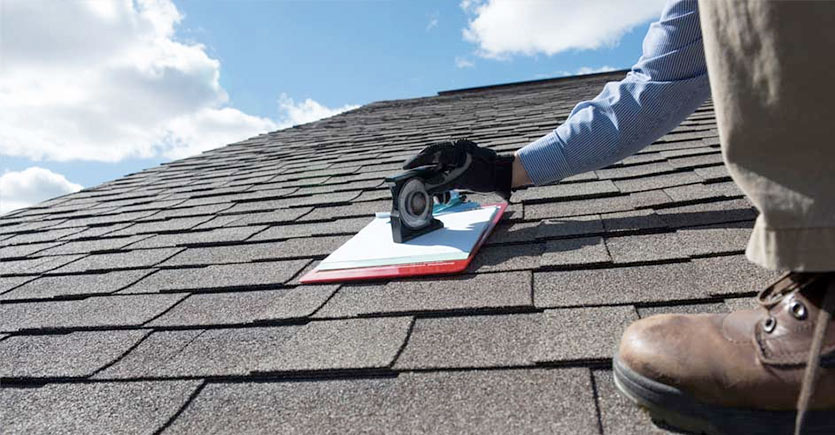Ensure quality by hiring a reputable Roofing Contractor for your project.
Ensure quality by hiring a reputable Roofing Contractor for your project.
Blog Article
Exactly How to Assess Different Roofing Alternatives for Your Structure Requirements
Assessing roof covering choices for your structure needs a thorough strategy that considers different aspects such as the planned usage of the framework, local climate problems, and material features. It is vital to weigh the benefits and disadvantages of different roof types, from asphalt roof shingles to metal and clay ceramic tiles, while also considering first costs and long-term maintenance. Additionally, comprehending energy effectiveness and visual allure can influence your decision. As you consider these factors to consider, one concern remains: which factors will eventually direct your choice for a lasting and visually pleasing roofing remedy?
Examining Your Building's Needs
To efficiently assess roof covering choices, start by thoroughly analyzing your building's requirements. Start by considering the building's planned usage, as different frameworks may require differing roof requirements. Residential roofing systems usually prioritize appearances and insulation, while industrial buildings may concentrate on durability and load-bearing capacity.
Following, evaluate the local environment conditions that will affect roof performance. Factors such as temperature changes, precipitation levels, and wind patterns can affect product choice and style. A roof covering system that masters a warm environment might not do as well in areas vulnerable to heavy snowfall or severe heat.
Additionally, examine the architectural honesty of your structure. Make certain that the existing framework can support the picked roofing products, specifically if taking into consideration much heavier alternatives. It is additionally important to review any regional building ordinance or policies that might determine certain requirements for roof.

Contrasting Roofing Materials
Once a comprehensive evaluation of your building's needs has been completed, the next step involves contrasting various roof covering products. Each product uses distinct advantages and disadvantages, making it necessary to align your choice with your specific demands and scenarios.
Asphalt roof shingles are commonly identified for their cost and ease of installation, making them a popular option for residential buildings. On the various other hand, steel roofing, known for its toughness and long life, can endure extreme weather condition problems yet may feature a greater first investment.
Clay and concrete floor tiles supply outstanding thermal insulation and aesthetic appeal, particularly for Mediterranean-style design, yet they need a more durable structural assistance as a result of their weight. Timber trembles offer a natural appearance and great insulation residential or commercial properties yet may require much more upkeep and are prone to fire risks.
Assessing Price and Budget
Examining your roofing options necessitates a careful analysis of cost and spending plan factors to consider. The overall allocate a roofing project makes up several aspects, including material expenses, labor expenses, maintenance, and potential long-lasting financial savings. It is important to establish a clear spending plan before exploring details roof covering products, as this will lead the decision-making procedure and help you stay clear of overspending.
Begin by obtaining quotes from several service providers to comprehend labor prices in your area. Make sure that these price quotes include all required services, such as elimination of the old roof covering, installment, and any type of additional features, like insulation or ventilation improvements - Toledo Roofer. Next, evaluate the price of different roofing products, considering both initial installation expenses and anticipated lifespan

Comprehending Energy Effectiveness
Energy efficiency plays an important role in the option of roof products and systems, substantially influencing both energy intake and overall convenience within a building. An appropriate roofing can improve thermal efficiency, lowering the demand for home heating and cooling systems, which in turn lowers energy bills and minimizes ecological influence.
When reviewing roofing alternatives, think about materials that you can find out more show instead of absorb warm. Light-colored or reflective roofing items can considerably reduce roof covering surface temperature levels, bring about lower power use during hot months. In addition, appropriate insulation and ventilation are vital to maximize the energy performance of the entire roofing system. Insulation protects against heat transfer, while ventilation minimizes warm buildup in the attic area.
One more crucial variable is the roof's long life and upkeep needs. Sturdy materials that need much less frequent replacement add to long-term energy cost savings. The power efficiency of a roof system can likewise be examined via its conformity with established sustainability rankings such as ENERGY STAR or LEED.
Considering Visual Charm
A roofing's visual appeal substantially affects the general look of a building, enhancing its architectural style and enhancing curb appeal. Toledo Roofer. When evaluating roof covering options, it is vital to consider exactly how the selected product, color, and design will integrate with the existing framework and neighborhood. A well-designed roof can raise even the simplest of buildings, my link changing them into visual centerpieces
Different roofing products supply numerous aesthetic top qualities. For instance, typical tiles might stimulate a timeless appeal, while metal roofing can pass on a modern-day, smooth appearance. Furthermore, the color of the roof material plays a vital role; lighter shades can make a building show up more roomy, while darker tones may produce a cozier ambiance.
Additionally, building elements, such as dormers and eaves, can improve the roof's aesthetic influence. It is advisable to seek advice from with specialist developers or engineers to make sure the chosen roof covering option straightens with the overall style intent. Eventually, a roof covering must not only provide useful benefits yet also contribute positively to the structure's aesthetic, showing the proprietor's taste and the personality of the surrounding setting.
Conclusion

Report this page